Traces of history before the museum: From the mansion of shirogane-choja, to a secondary residence of Matsudaira Yorishige, lord of the Takamatsu Domain, to the residence of Prince Asaka
![]()
![]()
事務局からのお知らせ
A Botanical Tour of the Tokyo Metropolitan Teien Art Museum, Now Celebrating Its 40th Anniversary
── Vice Director Muta started the tour at a spot near the parking lot, a short distance from the garden entrance, facing the neighboring Institute for Nature Study, National Museum of Nature and Science. “This is a sudajii tree (Castanopsis sieboldii),” he said, pointing at a lump on the ground.
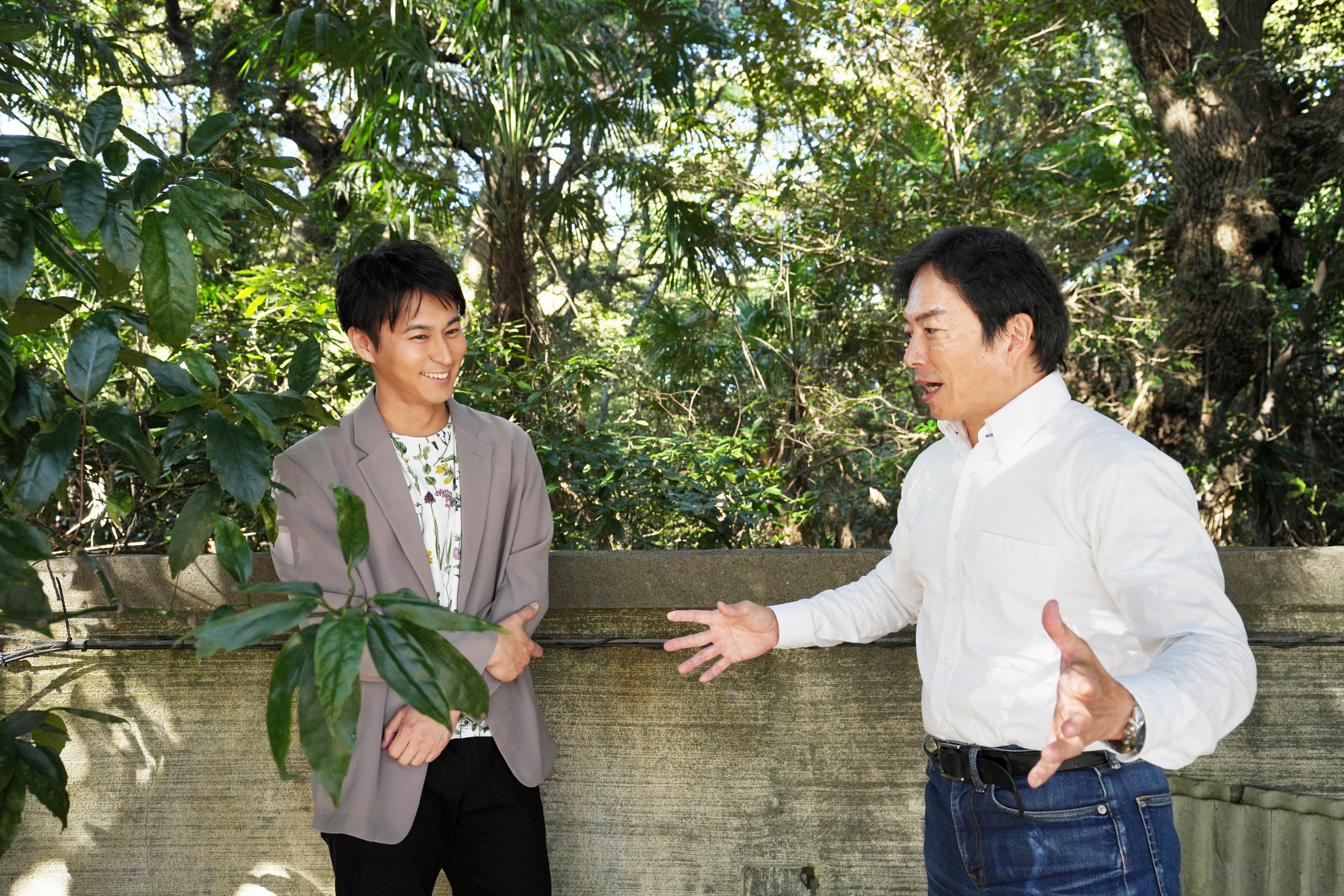
Muta: This is what remains of an earthwork (an earthen embankment used as a fortification) that runs from the grounds of the Teien Art Museum to the Institute of Nature Study next door. According to legend, sometime between the Kamakura (1185–1333) and Muromachi (1336–1573) periods, this was the site of the mansion of a powerful family known to be wealthy in silver, called the shirogane-choja. This area is a prime location with a plateau-like shape and excellent sun exposure. The current vegetation is said to date back to the Edo period (1603–1867), when the basic landscape was created, but the land itself is believed to have been covered in a lush, broad-leaved evergreen forest since the prehistoric Jomon period.
Mikami: I did not expect this tour to start in the parking lot (laughs). So this is where the history of the area begins.
── Just like the Teien Art Museum, which celebrated its 40th anniversary this year, actor and gardener Masashi Mikami was born in 1983 and is 40 years old. Born in Niigata Prefecture, he says he developed a love of gardening and plants at an early age thanks to his parents. Walking from the parking lot to the garden, a tree that seemed to be two trees joined together came into view.
Muta: This tree looks heart shaped, so I secretly call it the “tree that brings happiness.” There are Japanese rhinoceros beetles in this sudajii tree.
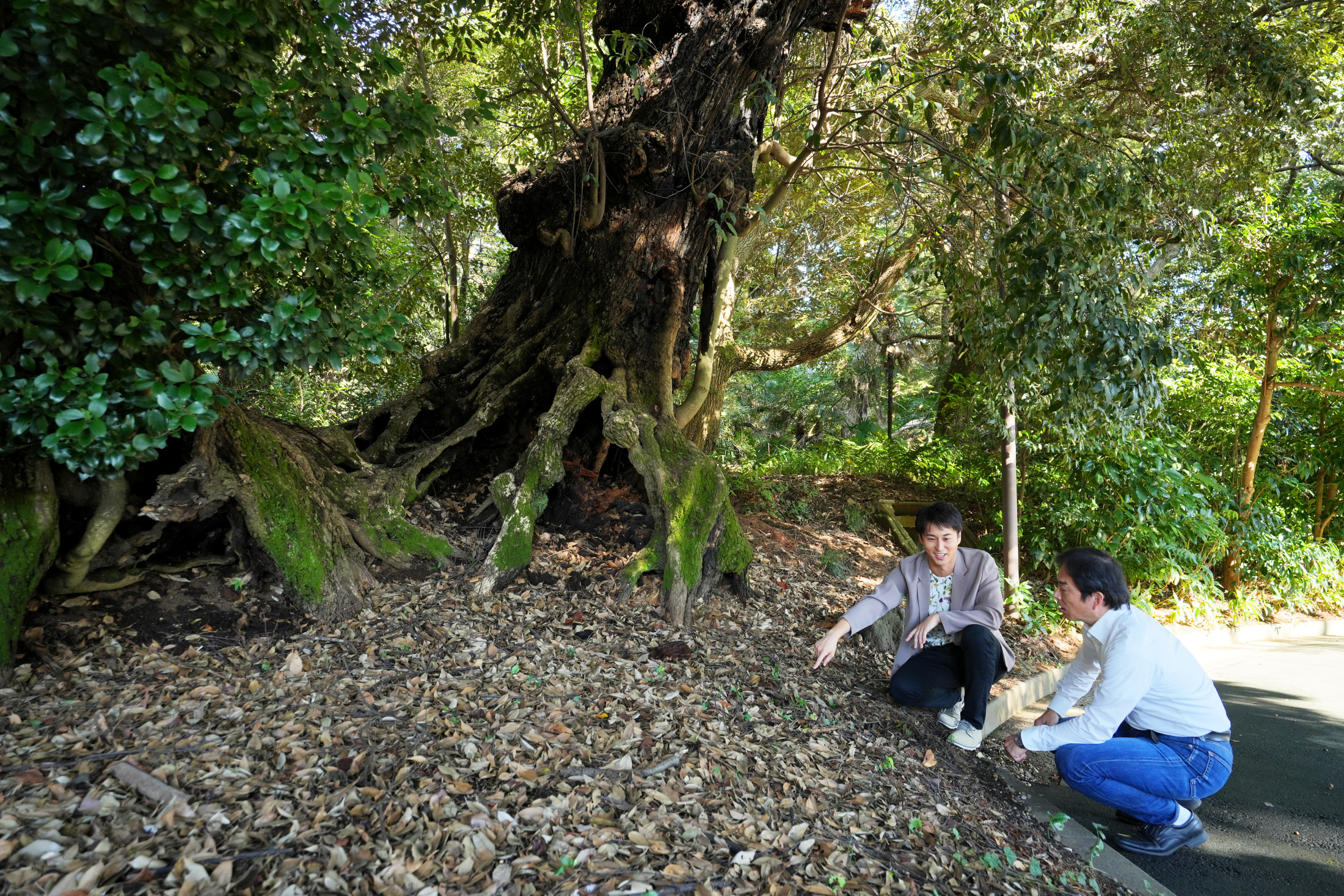
Mikami: These fallen leaves on the soil are excellent for Japanese rhinoceros beetles. The leaves decompose where they fall, creating a thick layer that covers the soil and becomes compost for the tree itself. I can feel the quality of the soil and the circulating life force of the tree.
Muta: During the Edo period, the area that is now the Institute of Nature Study and the Teien Art Museum became the shimoyashiki of Matsudaira Yorishige, a daimyo who ruled the Takamatsu Domain in Sanuki Province (now Kagawa Prefecture). Compared to the kamiyashiki, which was the administrative center and main residence of the feudal lord, the nakayashiki and shimoyashiki were used as retreats by retired lords or to grow vegetable gardens. During the Meiji era (1868–1912), the land became government property and was used as a gunpowder magazine by the Navy and other agencies. During the Taisho era (1912–1926), it was offered to the Imperial Household Ministry and renamed the Shirogane Imperial Estate. In 1933, the residence of Prince Asaka, which later became the Teien Art Museum’s Main Building, was built on a section of the property. If you look at the specifications for building the residence, it states that “usable trees should be left intact.” The garden was designed to utilize the native trees as much as possible, allowing the trees to remain in the garden over the decades.
Mikami: It’s amazing that this area has been protected from generation to generation, while leaving behind traces of its history.
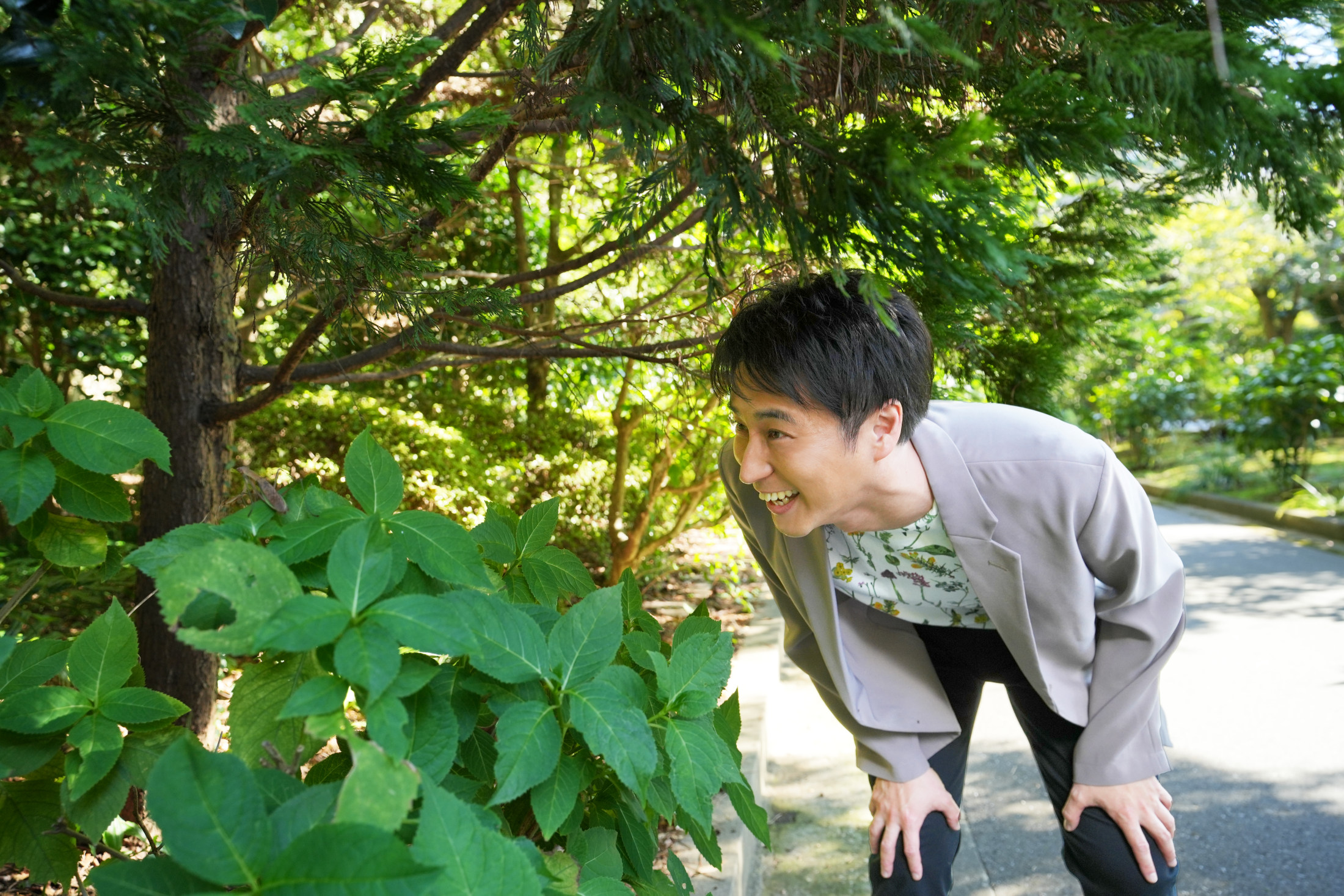
Muta: Incidentally, there is a story that the botanist Tomitaro Makino discovered the Torano-o-suzukake (Veronicastrum axillare), which is found only in Kyushu, three prefectures in Shikoku excluding Tokushima Prefecture, and the Ise-Shima area, at the current site of the Institute of Nature Study. Why was the Torano-o-suzukake growing in Tokyo? Hiraga Gennai, who was ordered to create an herb garden by Matsudaira Yoritaka, the fifth lord of the Takamatsu Domain, may have brought the seeds from his hometown and cultivated them here during the Edo period, when this area was a part of the daimyo’s residence.
Mikami: I appeared in NHK’s TV show Ranman (a morning drama series based on the life of Tomitaro Makino), and like Dr. Makino, I myself enjoy going on plant adventures. I also introduced Hiraga Gennai in my own TV program.
Muta: Unfortunately, we haven’t seen the Torano-o-suzukake at the Teien Art Museum.
Encountering cherry blossom trees from Washington, D.C., muku trees, and other plants in the Lawn Space, Japanese Garden, and European Garden
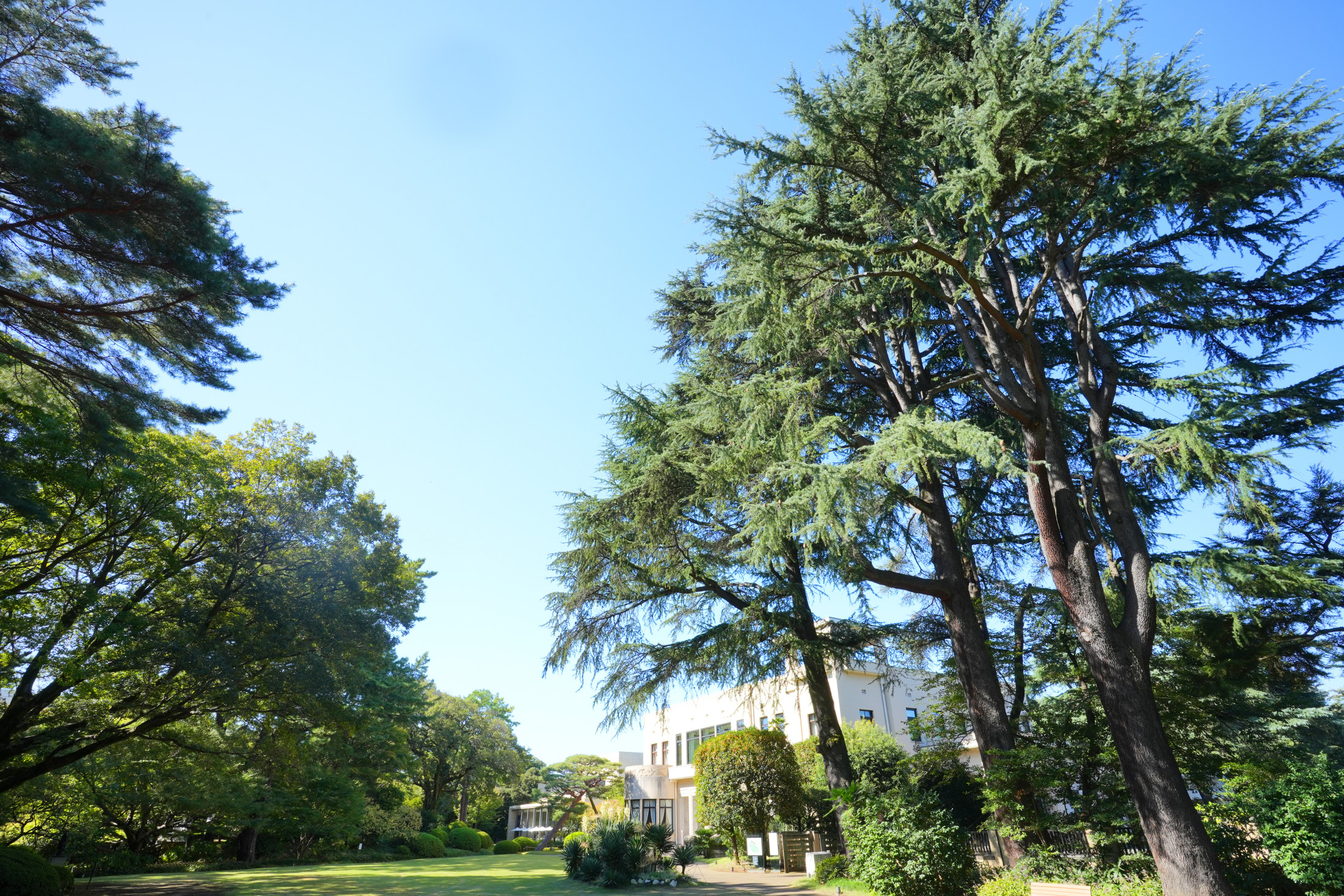
── The garden that existed during the Prince Asaka Residence era has been retained as the present-day Lawn Space and Japanese Garden, while the site of the officials’ quarters has been converted into the present-day European Garden. Each of the three gardens has its own unique atmosphere. First on the tour was the Lawn Space.
Muta: During the Prince Asaka Residence era, the botanist Taketane Soma, who was the first person to succeed in growing an evergreen grass lawn in Japan, served as an official of the Imperial Household. Although this is not an evergreen lawn, I believe they may have received his advice when creating it.
Mikami: It’s so beautifully maintained! (Mikami lies down on the grass.) Not only do you see the blue sky, but the large trees frame the view and make it look like a painting up above.
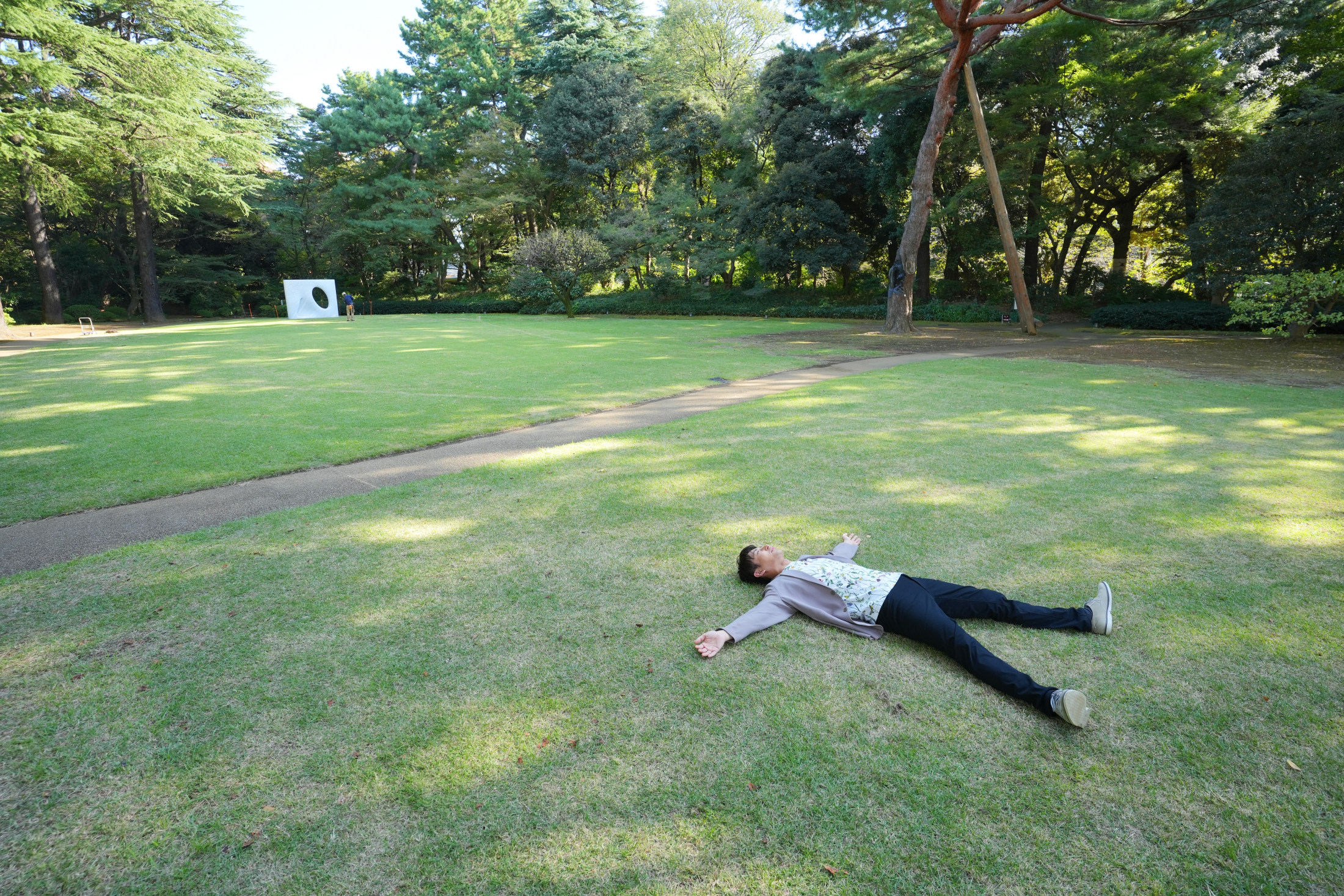
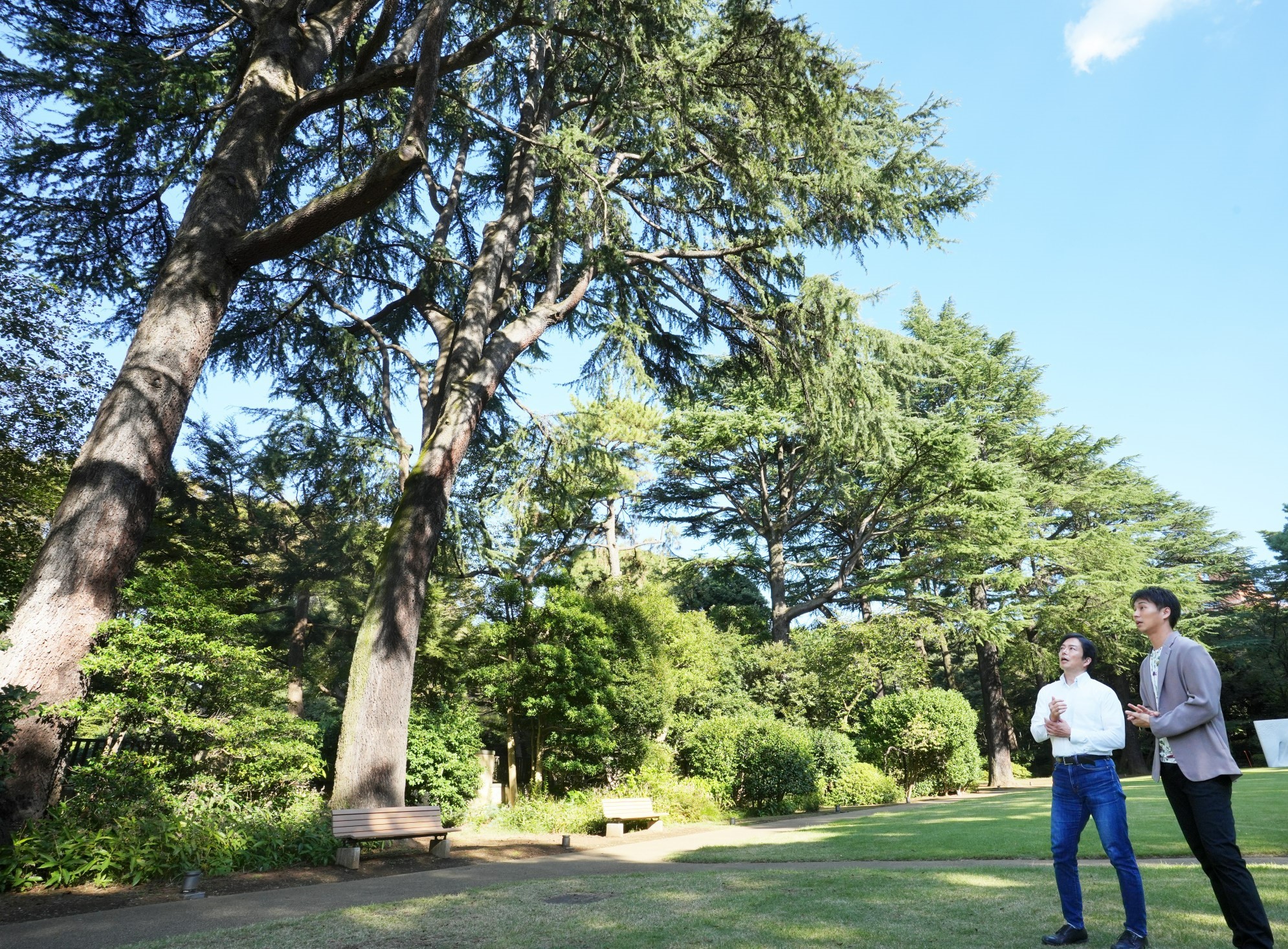
Muta: These trees are Himalayan cedars (Cedrus deodara). For some reason, there are Himalayan cedars at residences of the Imperial Family. These ones were planted when the Prince Asaka Residence was built, and they look small in photos from that time. Their cedar cones have a really beautiful natural shape.
Mikami: They are called “cedar roses” because they’re shaped like roses. I do flower arrangements and use them in wreaths and other garlands.
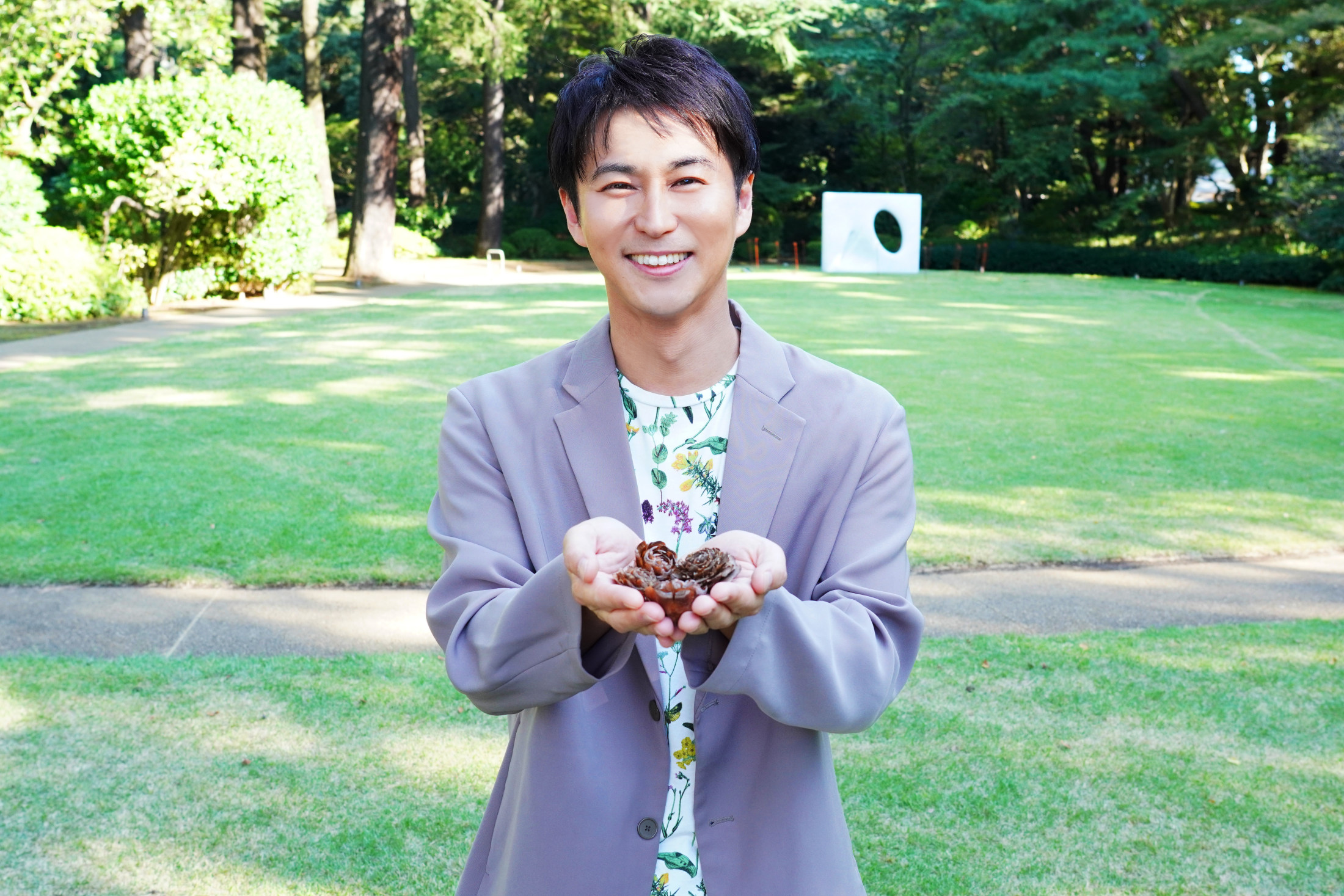
── Mikami and Muta headed toward the European Garden while admiring the beautiful Lawn Space. On the way, they passed through an area thickly grown with bamboo grass and soon spotted a pine grove.
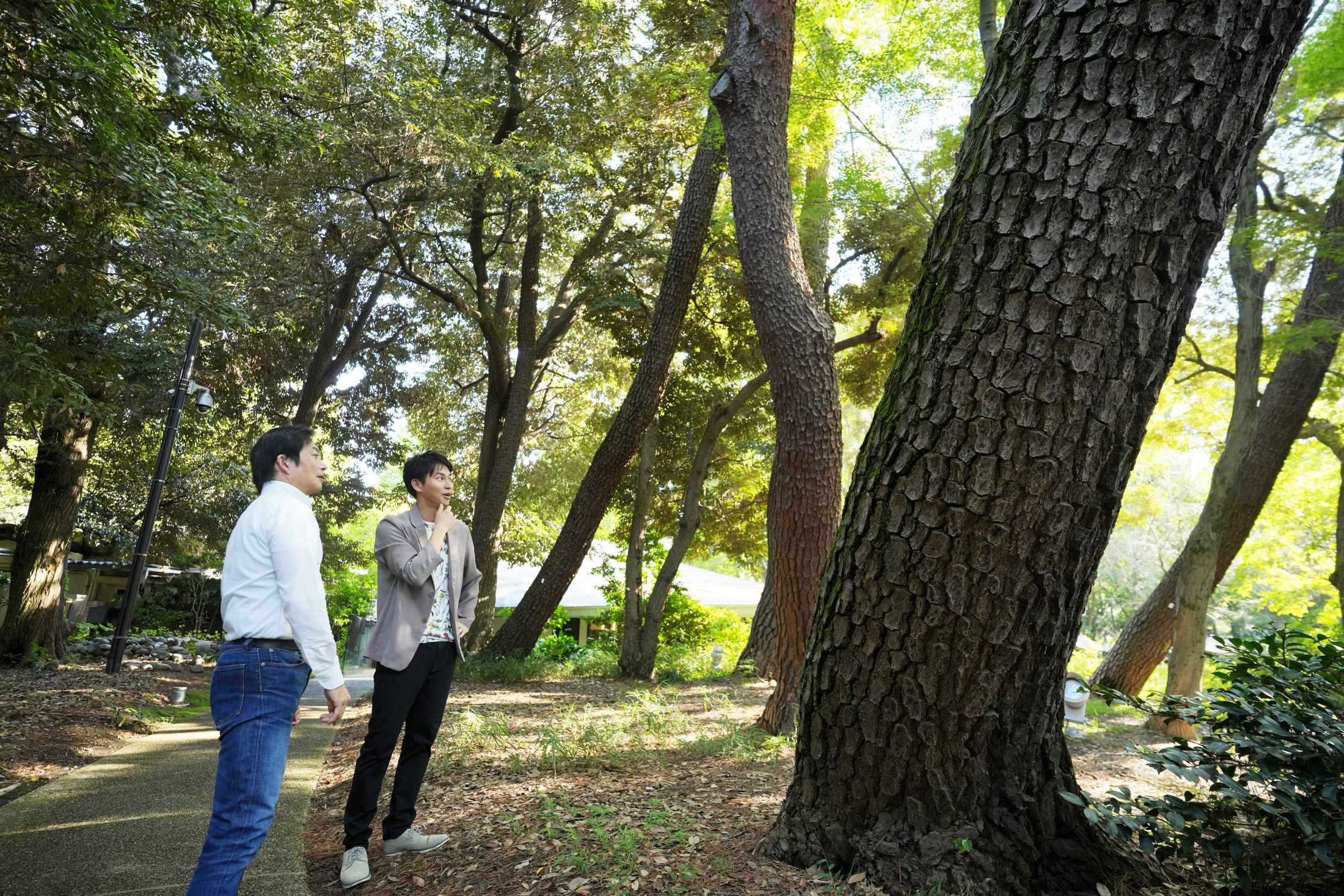
Muta: There used to be a shrine somewhere around here dedicated to the sun goddess Amaterasu Omikami.
Mikami: It does have a somewhat solemn atmosphere.
Muta: The reason there are so many pine trees here is because daimyo residences were encouraged to plant trees to compensate for the frequent fires that broke out during the Edo period. Chestnut, pine, and other lumber trees useful for construction were recommended. If you go to the Institute for Nature Study, you’ll find many pine trees with names such as the “Fabled Pine” and “Great Serpent Pine,” which are thought to be the vestiges of a stroll garden from its shimoyashiki era.
── The scenery changed abruptly as Mikami and Muta exited the pine grove and arrived at the spacious European Garden. Visitors can gaze out at the European Garden from the TEIEN Restaurant comodo.
Muta: These are cherry blossom trees. In 1912, cherry blossom tree saplings from the banks of the Arakawa River were sent to Washington, D.C. as a sign of friendship between Japan and the United States. Today, the banks of the Potomac River are a famous cherry blossom viewing spot. Some of those trees were sent back to Japan 80 years later, and were planted here. They’re “returnee trees.”
Mikami: (Laughs) They were able to take root here and grow into magnificent trees that bloom every year because this soil is of such good quality. I will enjoy viewing the blossoms.
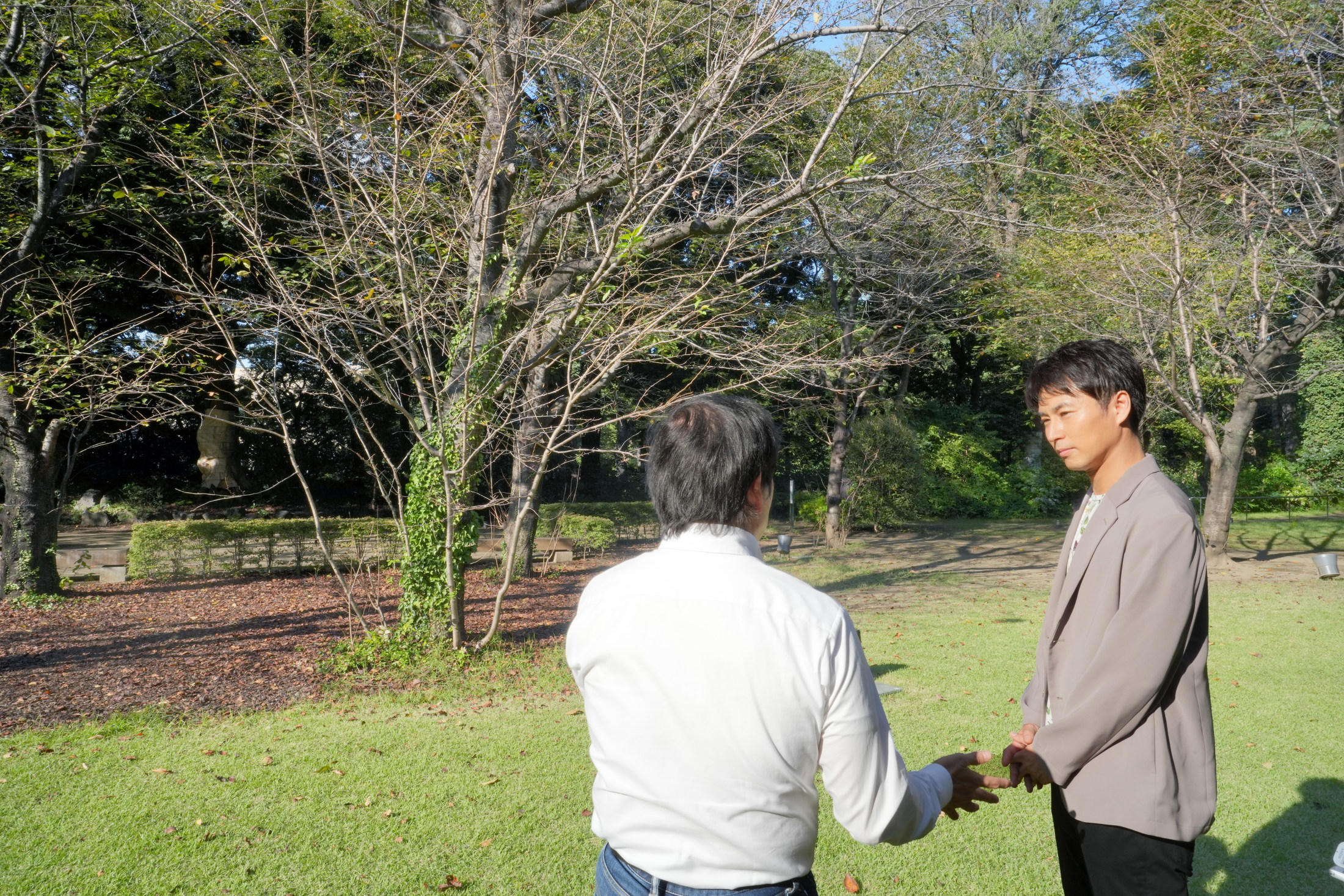
Muta: This time of year is great for “persimmon viewing.” In fact, I’ve asked the staff at the restaurant if they could create a menu using these persimmons.
Mikami: They could make hoshigaki (dried persimmons), or even jam. I have a feeling the garden is really blessed if the trees bear fruit every year without fertilizer!
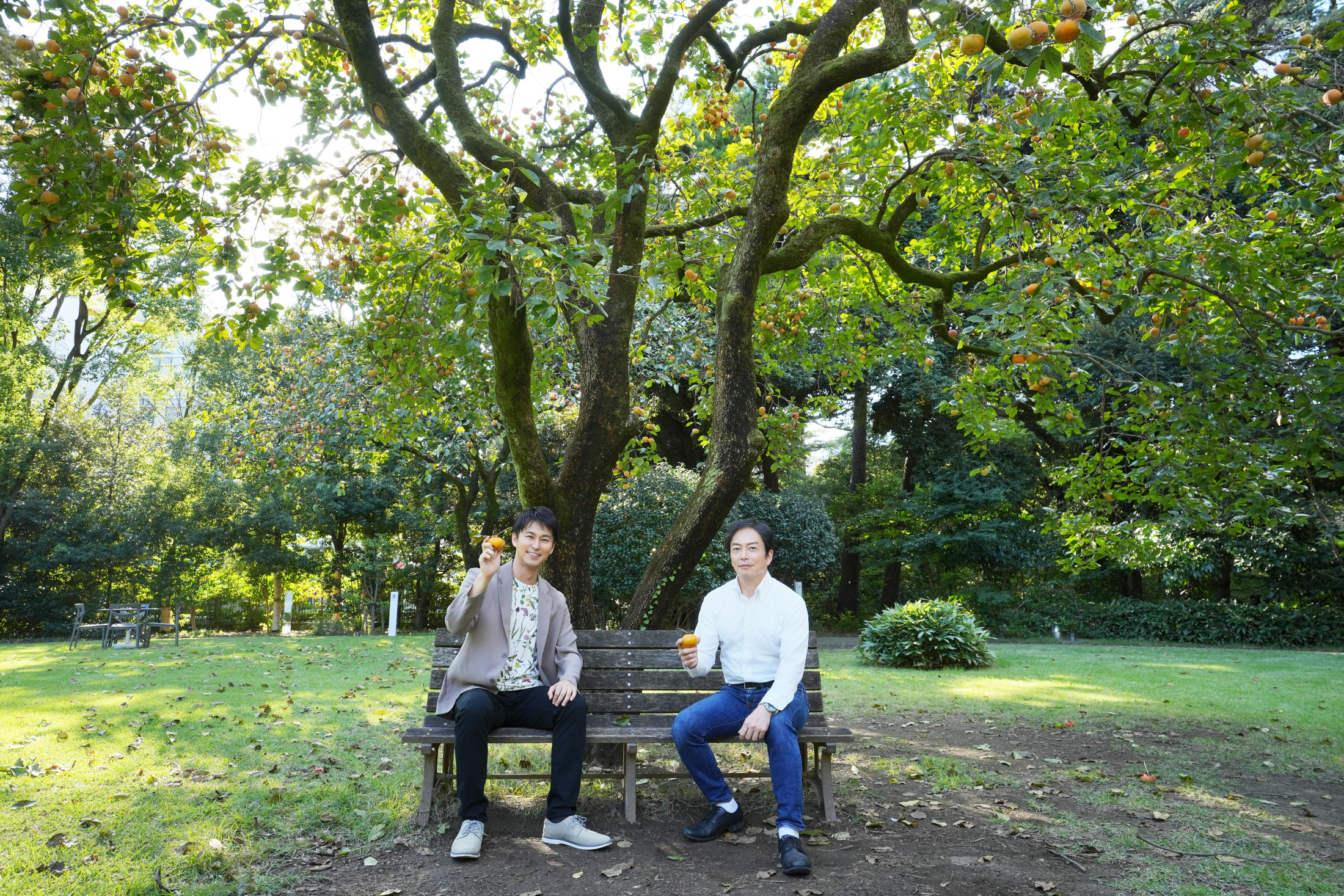
── Leaving the European Garden behind, Mikami and Muta headed to the Japanese Garden, which is a traditional stroll garden designed with artificial hills and ponds. Mikami walked along the undulating footpath, pointing out Japanese plants: “This is the purple beautyberry (Callicarpa dichotoma) , and this is probably a toad lily (Tricyrtis hirta).”
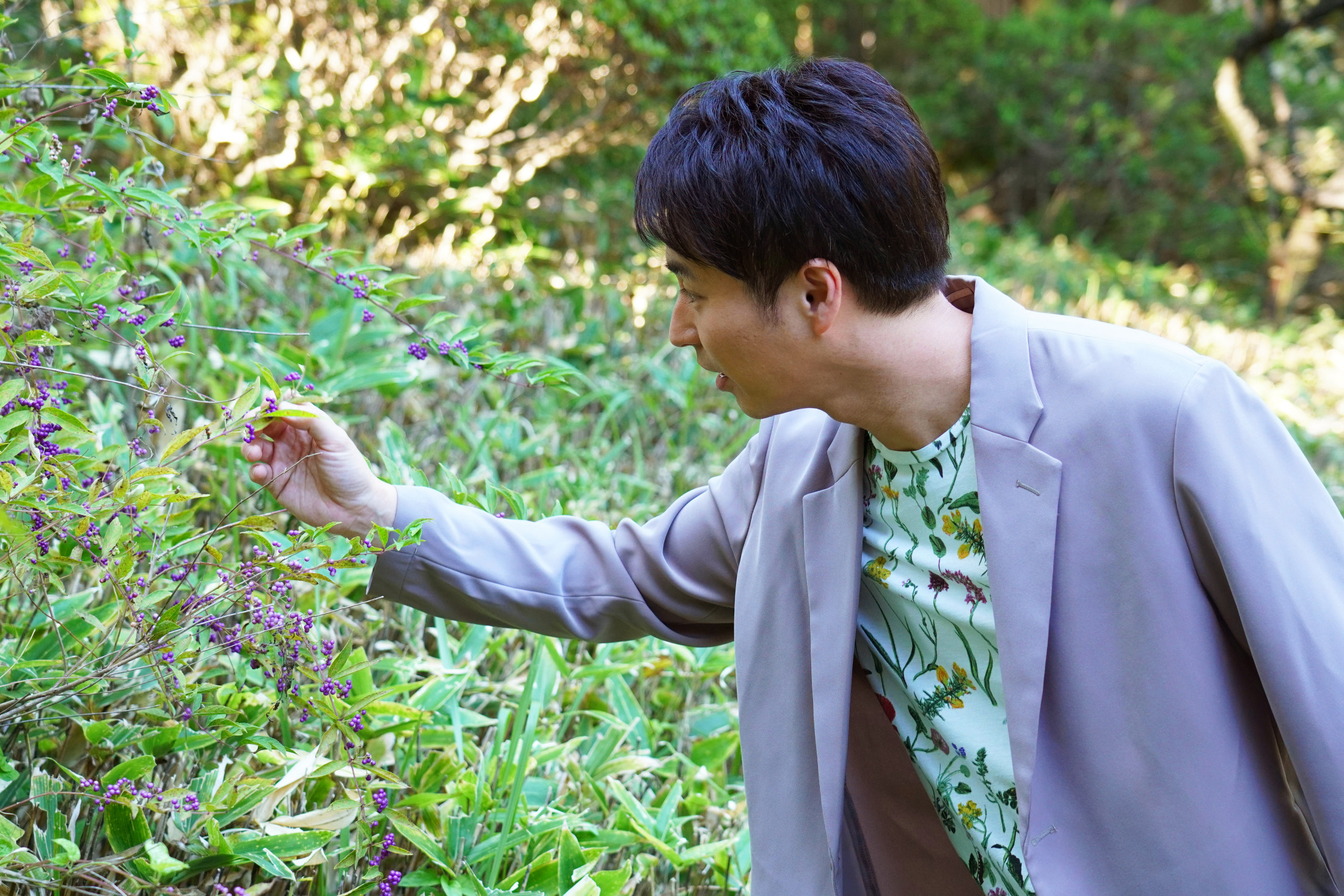
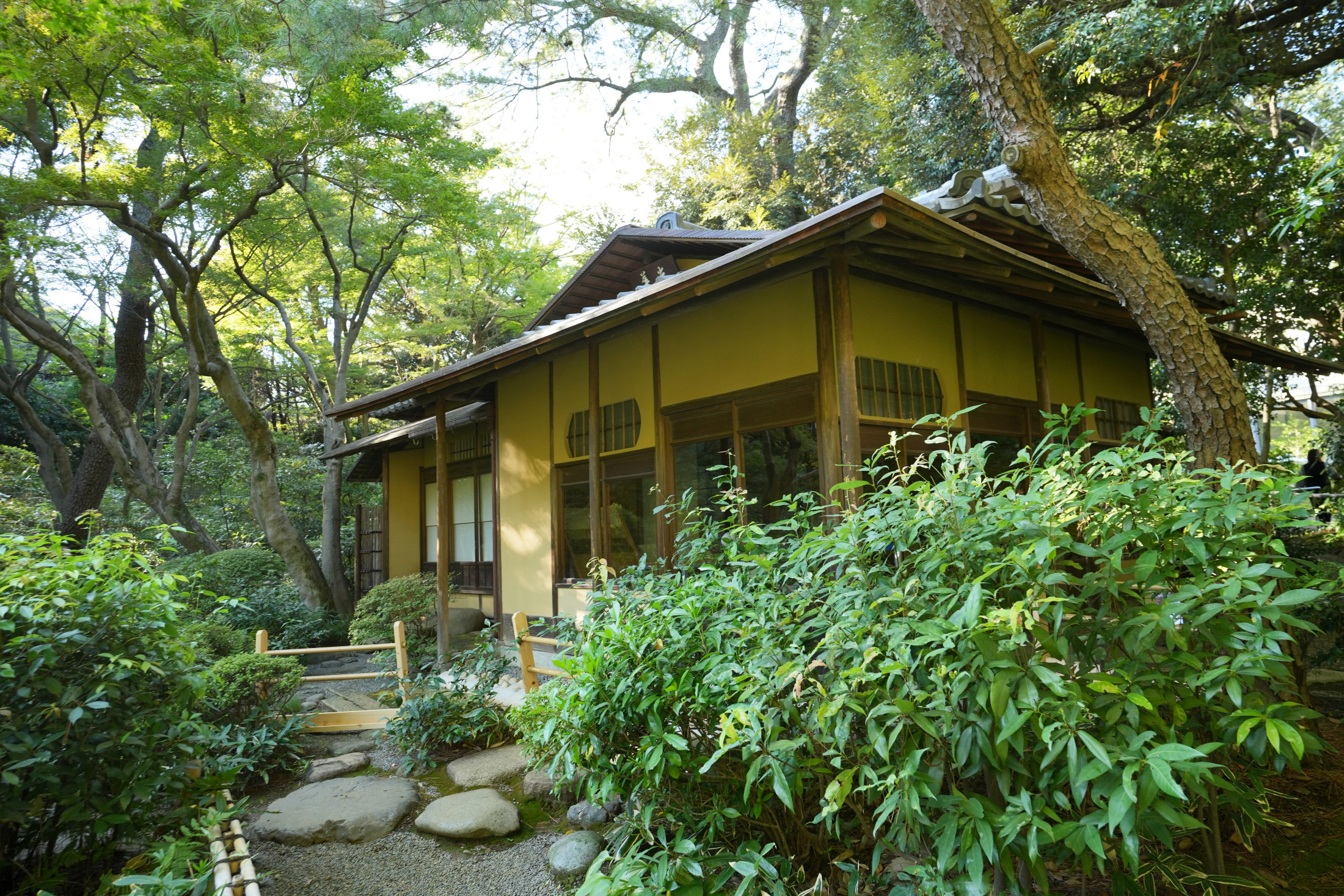
Muta: This is the Kōka Teahouse. The Prince Asaka Residence served as both a residence and a guest house. This teahouse was a space for entertaining guests from overseas, so it is designed to allow international visitors to sit in chairs while enjoying tea. We also hold seasonal tea ceremonies at the museum.
Mikami: Enjoying tea with a view of this pond—what a luxury!
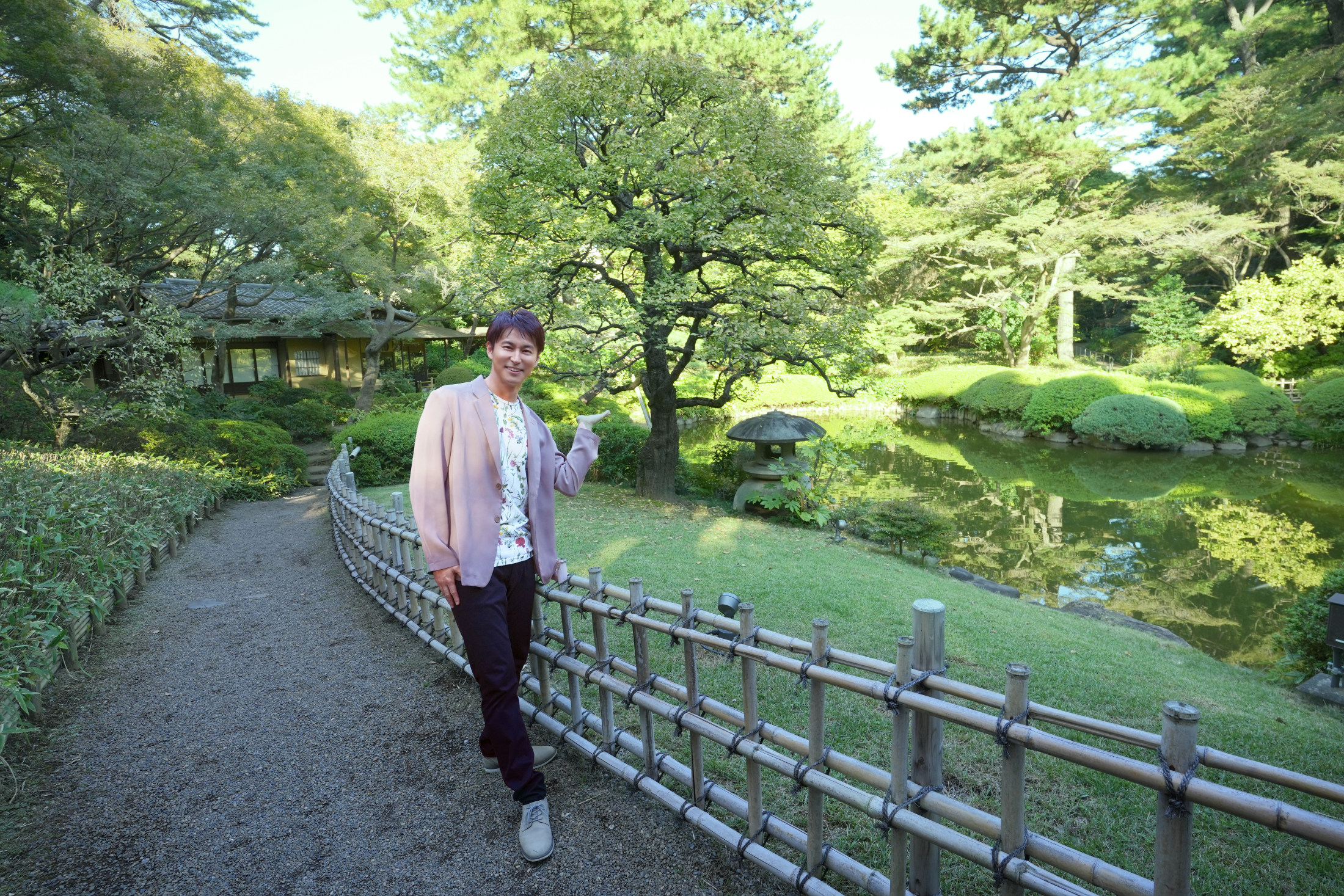
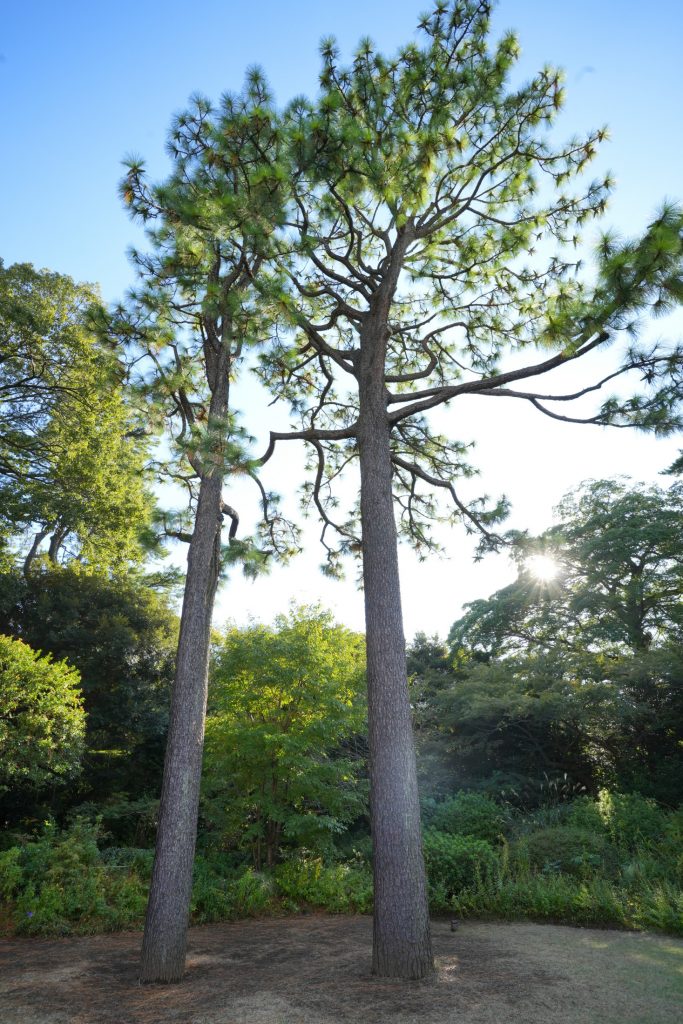
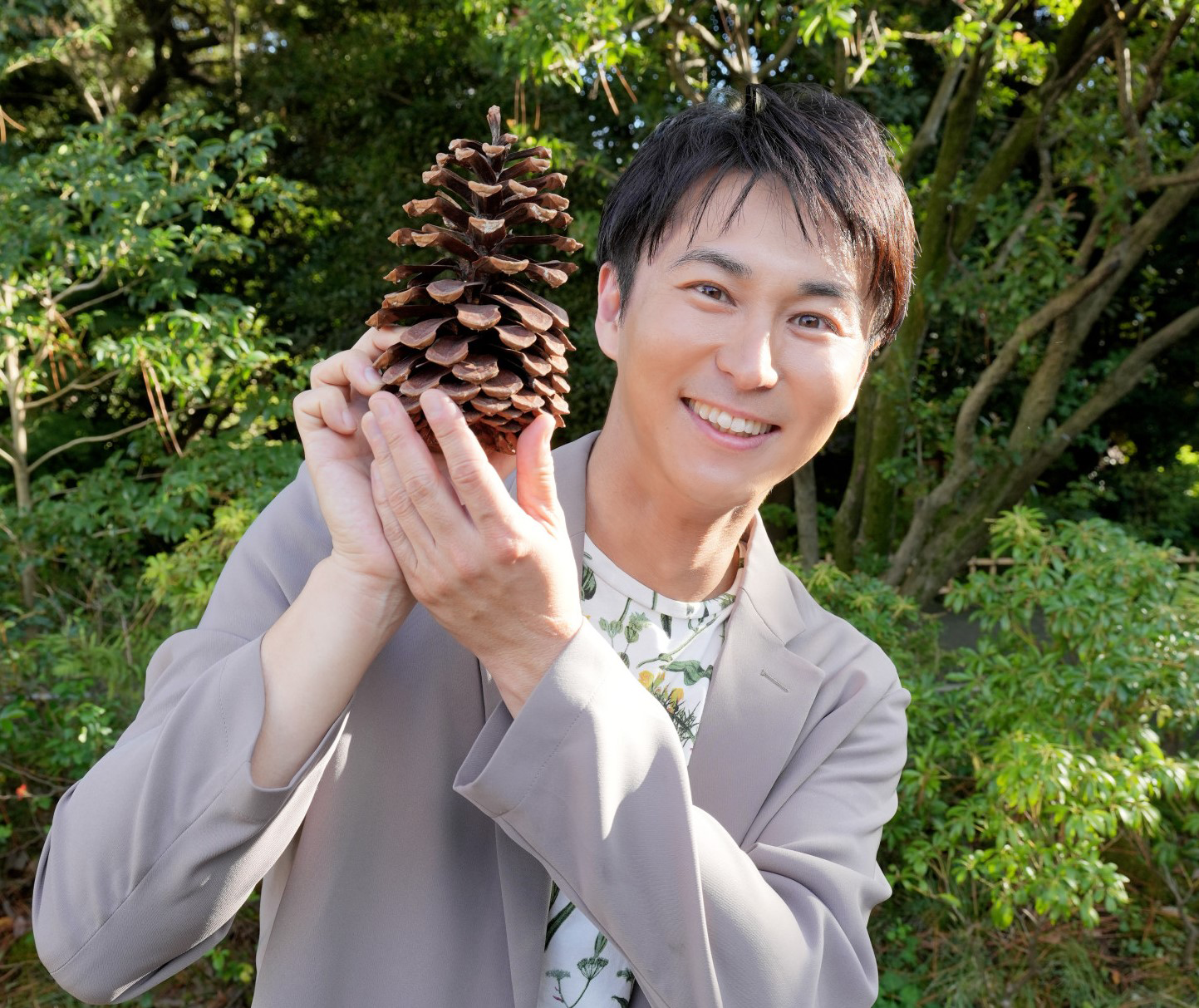
Muta: These are longleaf pine trees (Pinus palustris).
Mikami: Wow, they’re huge! This time of year, I always walk around with my son picking up pinecones. He would be shocked to see this one.
── After making a loop around the three gardens, Mikami and Muta ended up back at the Lawn Space.
Muta: This giant Chinese hackberry (Celtis sinensis) tree has been as a landmark in the area since before the construction of the Prince Asaka Residence, and next to it is a muku tree (Aphananthe aspera). The muku tree was transplanted here later. It was originally located around where the bay window of the Great Dining Room in the Main Building (former residence of Prince Asaka) is now. When they were building the residence in 1931, they uprooted this huge tree, which was more than 300 years old at the time, and moved it about 160 meters away.
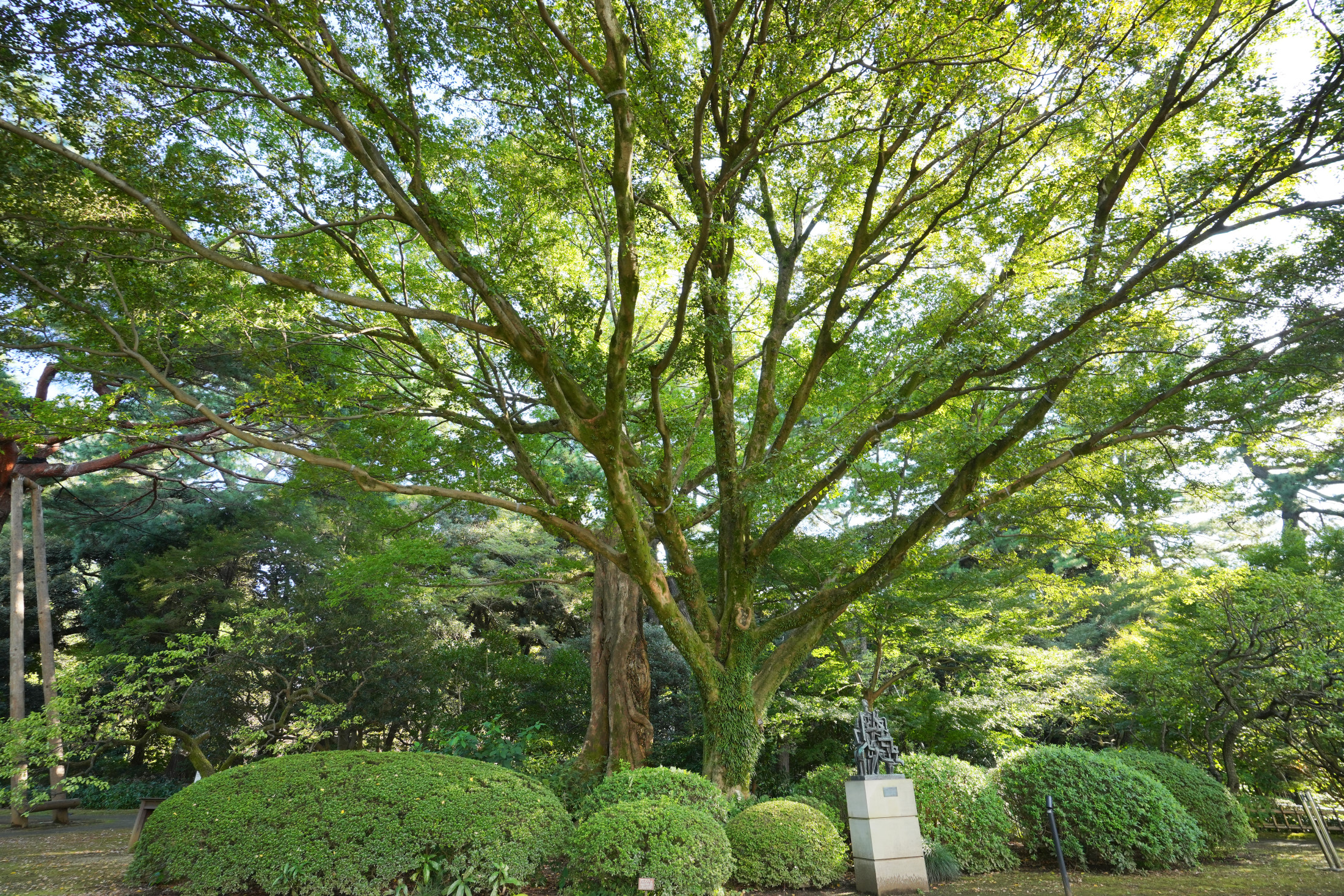
Mikami: Transplanting that tree must have been a huge job. But the soil is good, so it looks like it has taken root properly.
Muta: This is a symbolic tree for the museum, and we have held all kinds of events under it to commemorate our 40th anniversary. On October 1, we held a music and dance performance here. From October 20 until November 19, we will decorate this tree with ornaments and do projection mapping on it.
Mikami: I’d love to see that! Many gardens do illumination events, but I don’t think projection mapping is very common. I bet it will look fantastic because the tree has such a beautiful shape, with its branches spreading out laterally like the unryu-gata ring-entering ceremony performed by Yokozuna (sumo wrestlers).
Muta: Doing projection mapping on a tree is a first for the museum. We also revamped our Garden Map and added information about plants in honor of our 40th anniversary.
Mikami: I help botanical gardens with this type of work from time to time, and I really like the warmth these plant illustrations lend to the map.
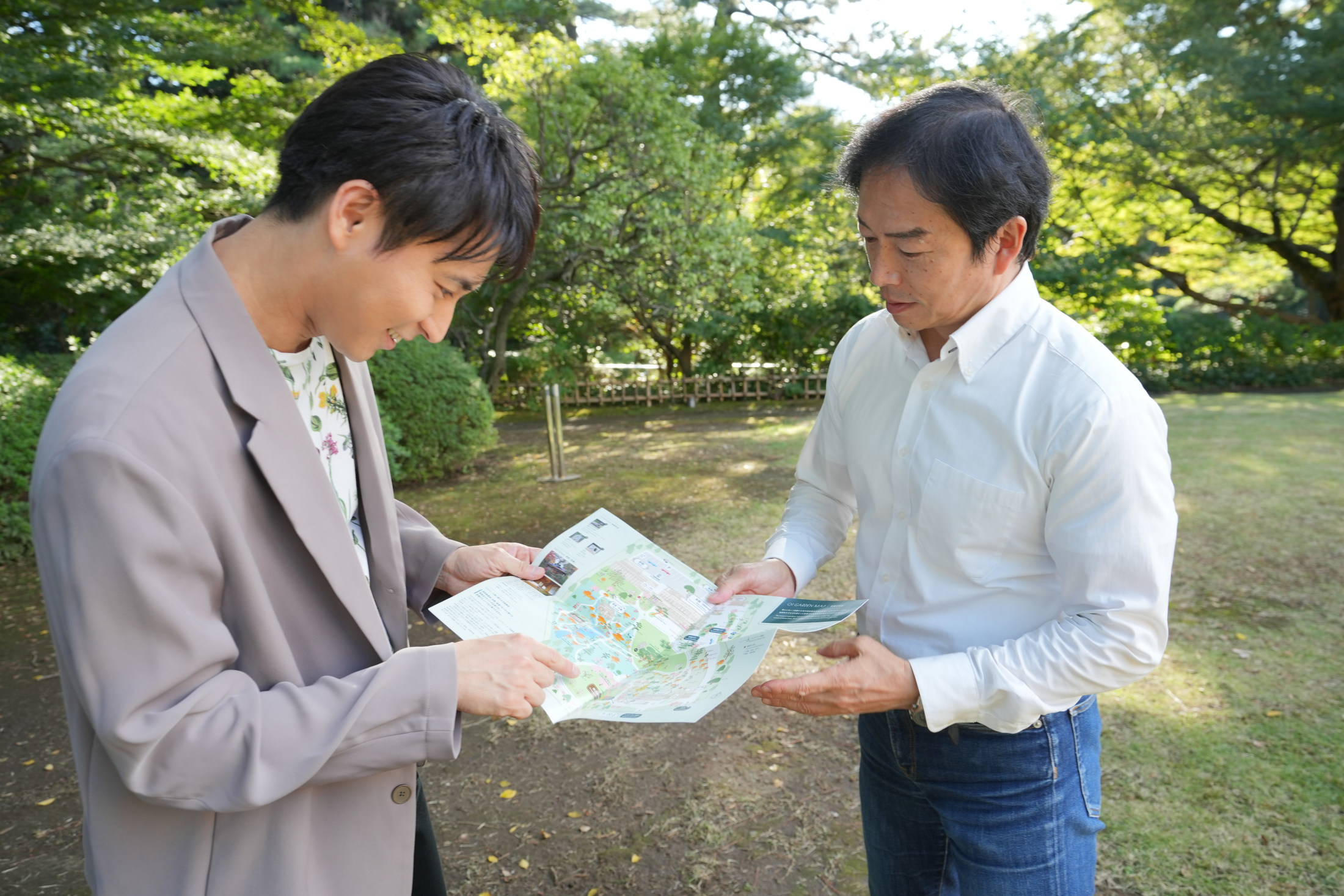
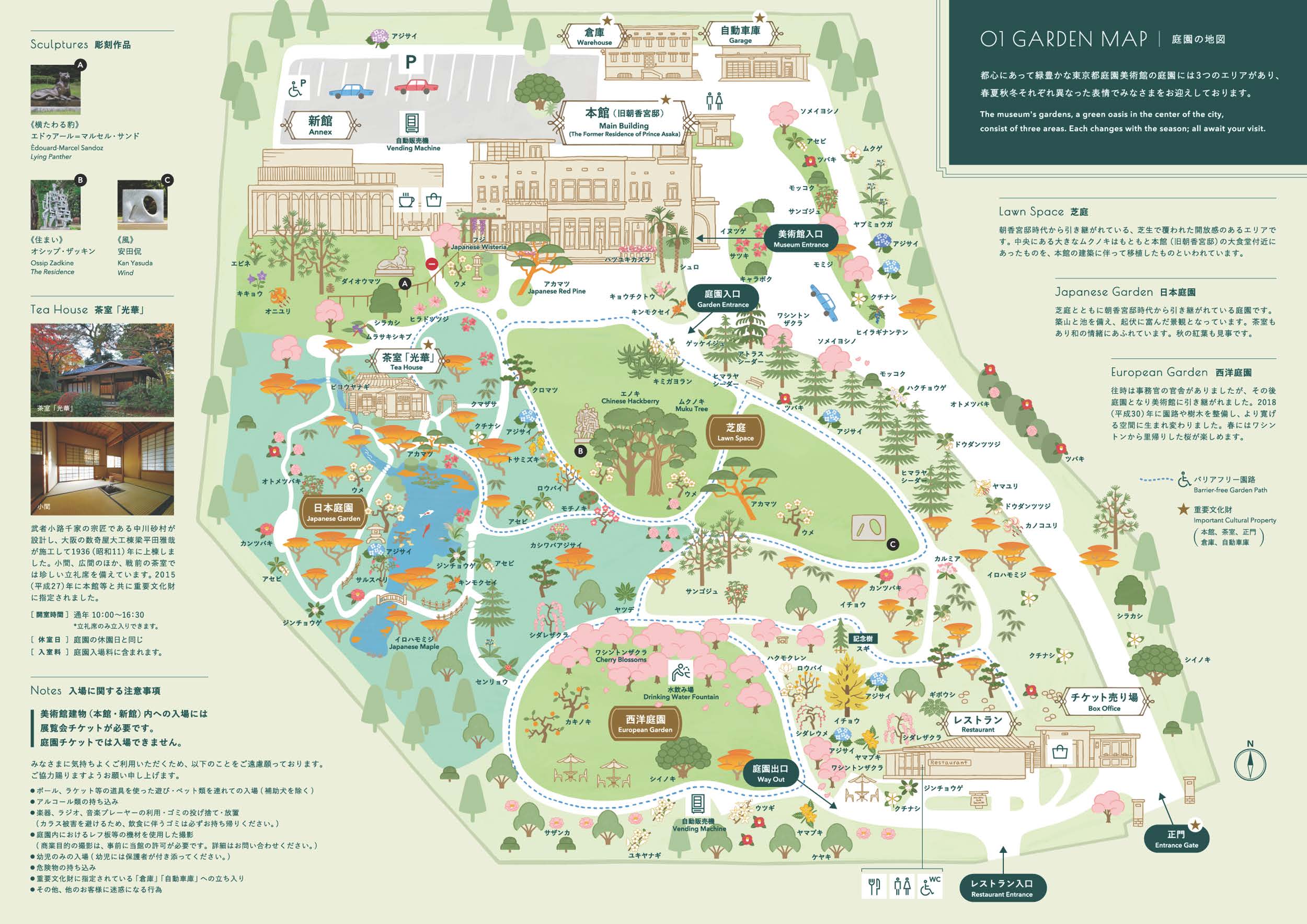
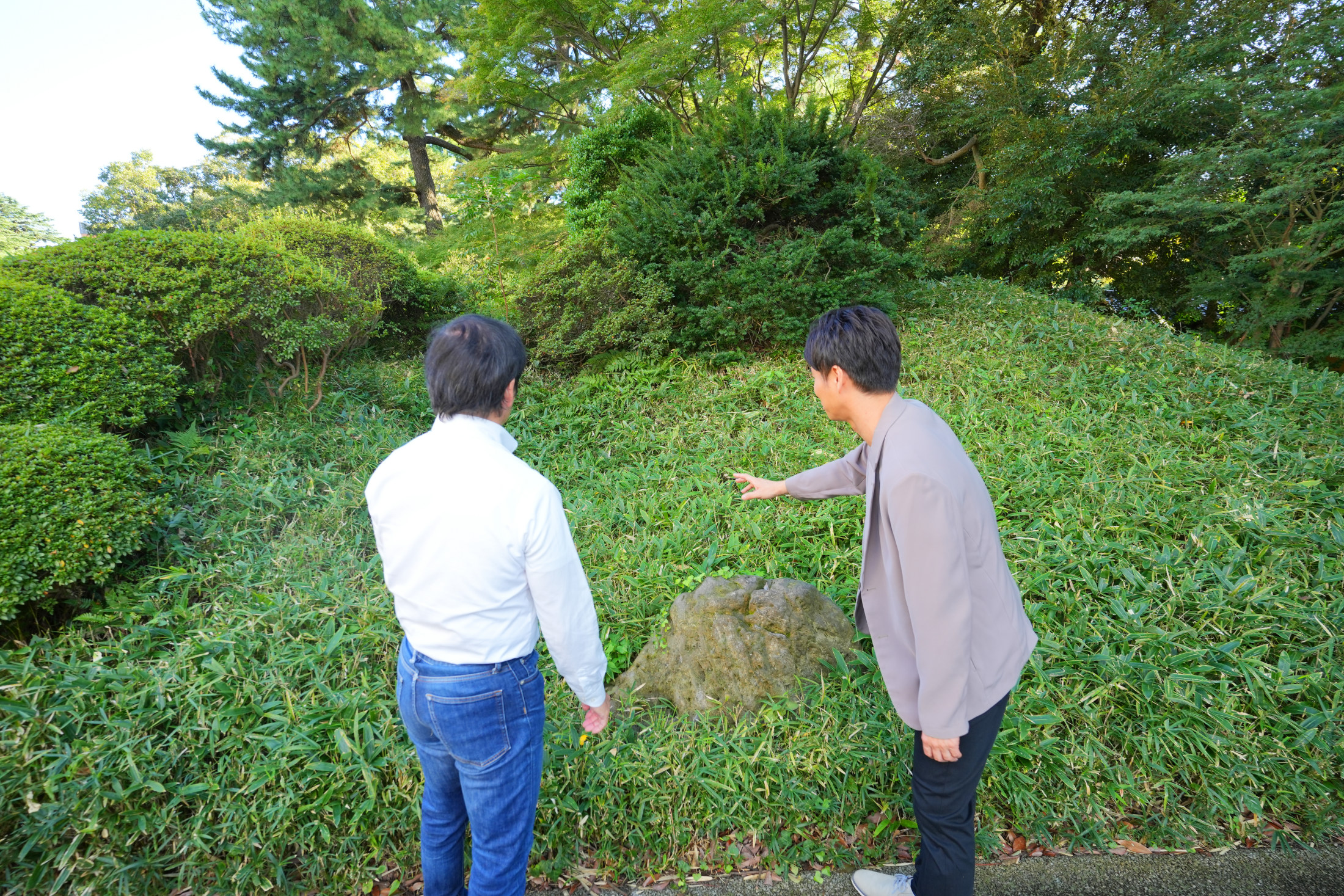
── On the way to the Main Building, Vice Director Muta pointed out the remains of a bomb shelter from the Prince Asaka Residence era. It has since been backfilled, but there was once a concrete semi-underground space here around eight tatami mats in size (about 13 m2). Regarding the current world situation, Mikami commented, “We can’t ignore what’s going on right now. It could happen to anyone.” In total, there are the remains of three bomb shelters in the garden.
Staying indoors but feeling outdoors: Decorations connect the museum to the garden
── Inside the museum, the 40th anniversary exhibition, titled The Art Deco Garden: Exploring the Aesthetic Fruits of the Residence of Prince Asaka, has been going on since Sunday, December 10.
Muta: This exhibition introduces decorations associated with the former residence of Prince Asaka and garden décor from the Art Deco period. On the first floor of the Main Building, decorations from the residence of Prince Asaka are used to explain the garden and plant motifs that form the basis for such décor.
Mikami: Seeing the garden after the exhibition would help visitors understand it better.
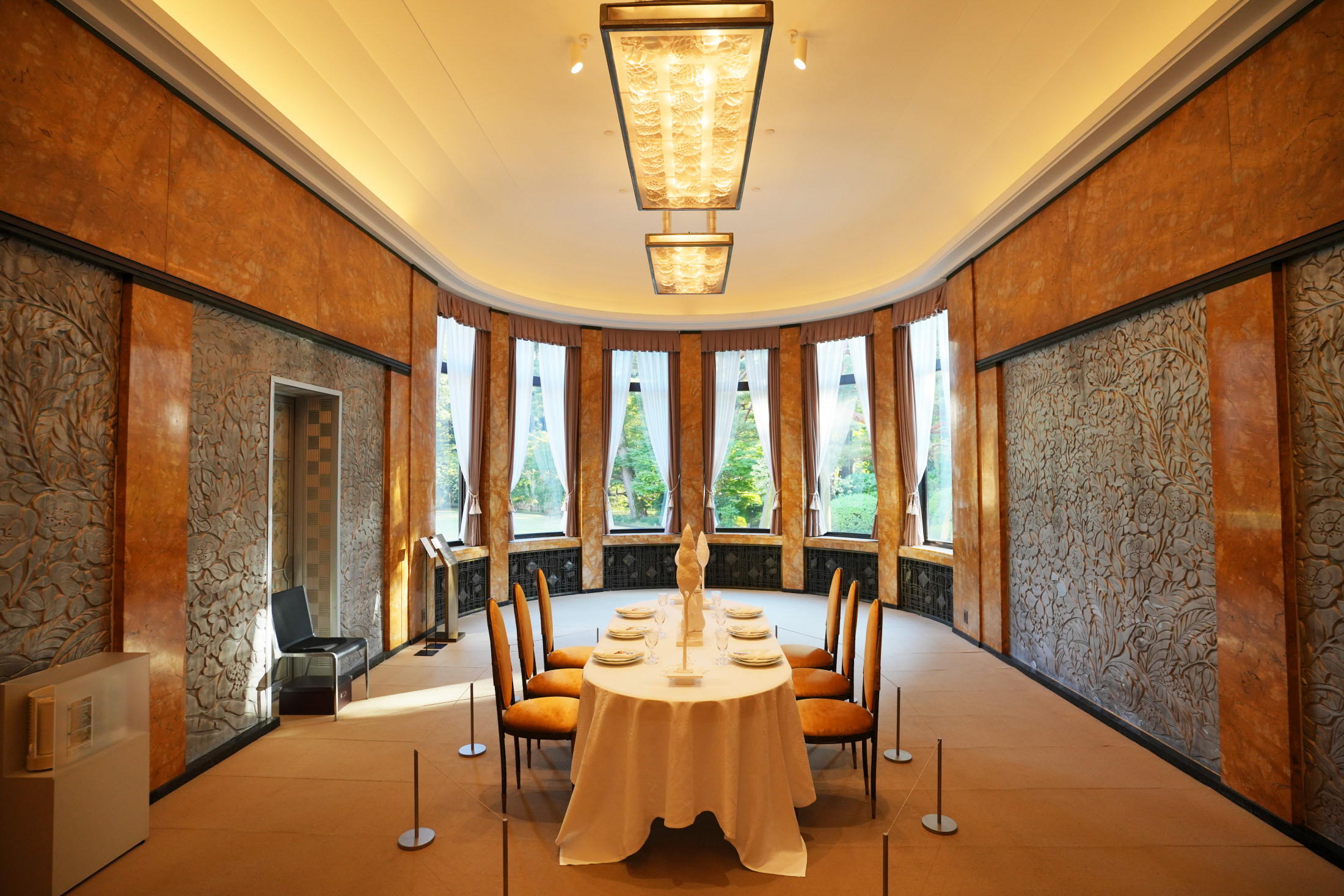
Muta: You’re right. This Grand Dining Roomwas a space for entertaining guests, and it incorporates a richly decorative style that was trendy in Paris at the time. The organic botanical pattern in the wall relief is similar to the Art Nouveau style that preceded Art Deco. The relief was designed by sculptor Ivan-Léon-Alexandre Blanchot and was originally made of concrete, but it was damaged in transit from France and had to be remade in Japan from plaster and finished with a silvery paint.
Mikami: I see a lot of plants and fruits, such as grapes, have been used as motifs.
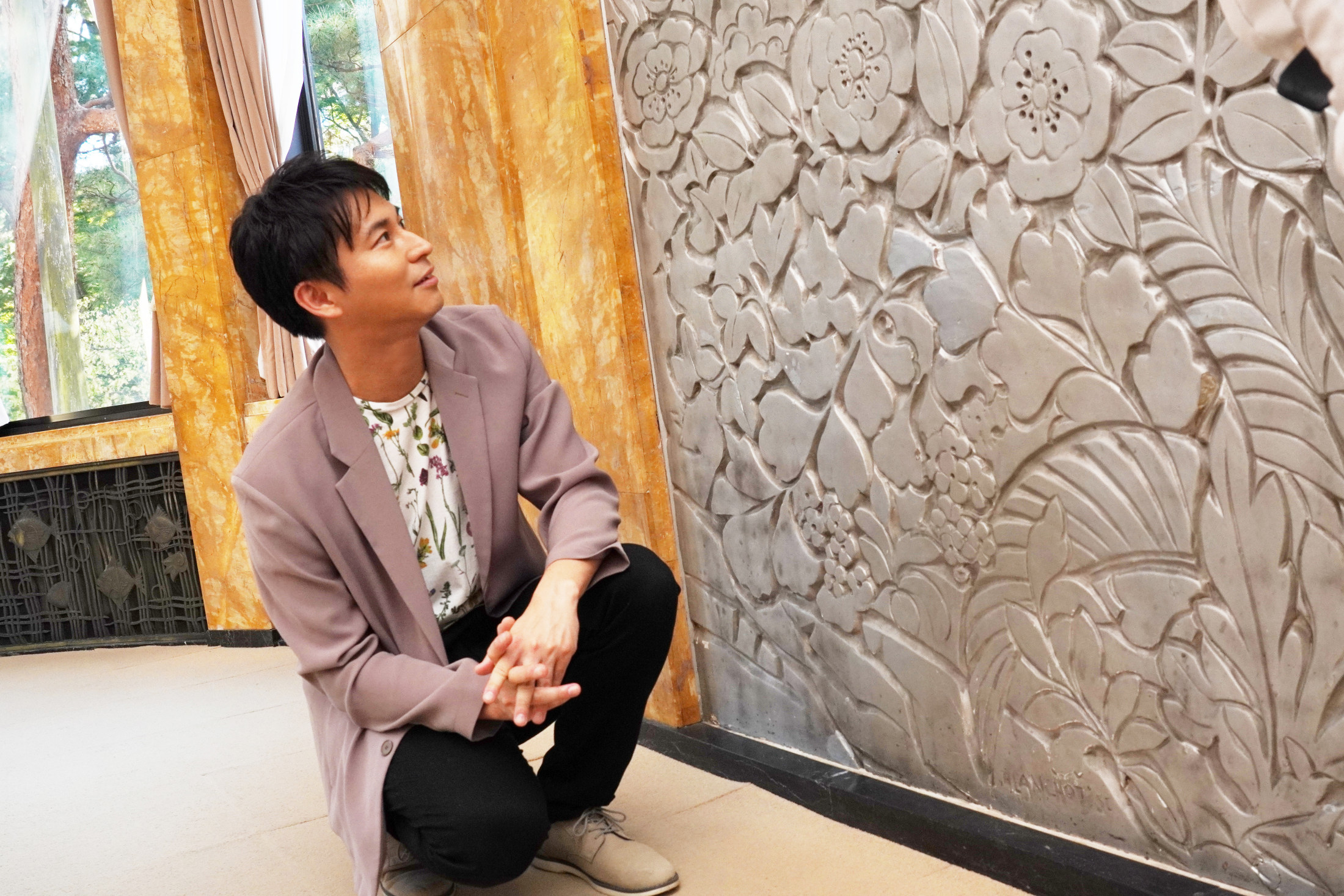
Muta: When Princess Nobuko Asaka was staying in Paris, she painted plants in watercolors under the instruction of Blanchot, the artist who designed this wall relief. I believe she asked Blanchot to do the interior design partly to serve as a memento of her time in Paris.
Mikami: This is a wonderful lighting fixture.
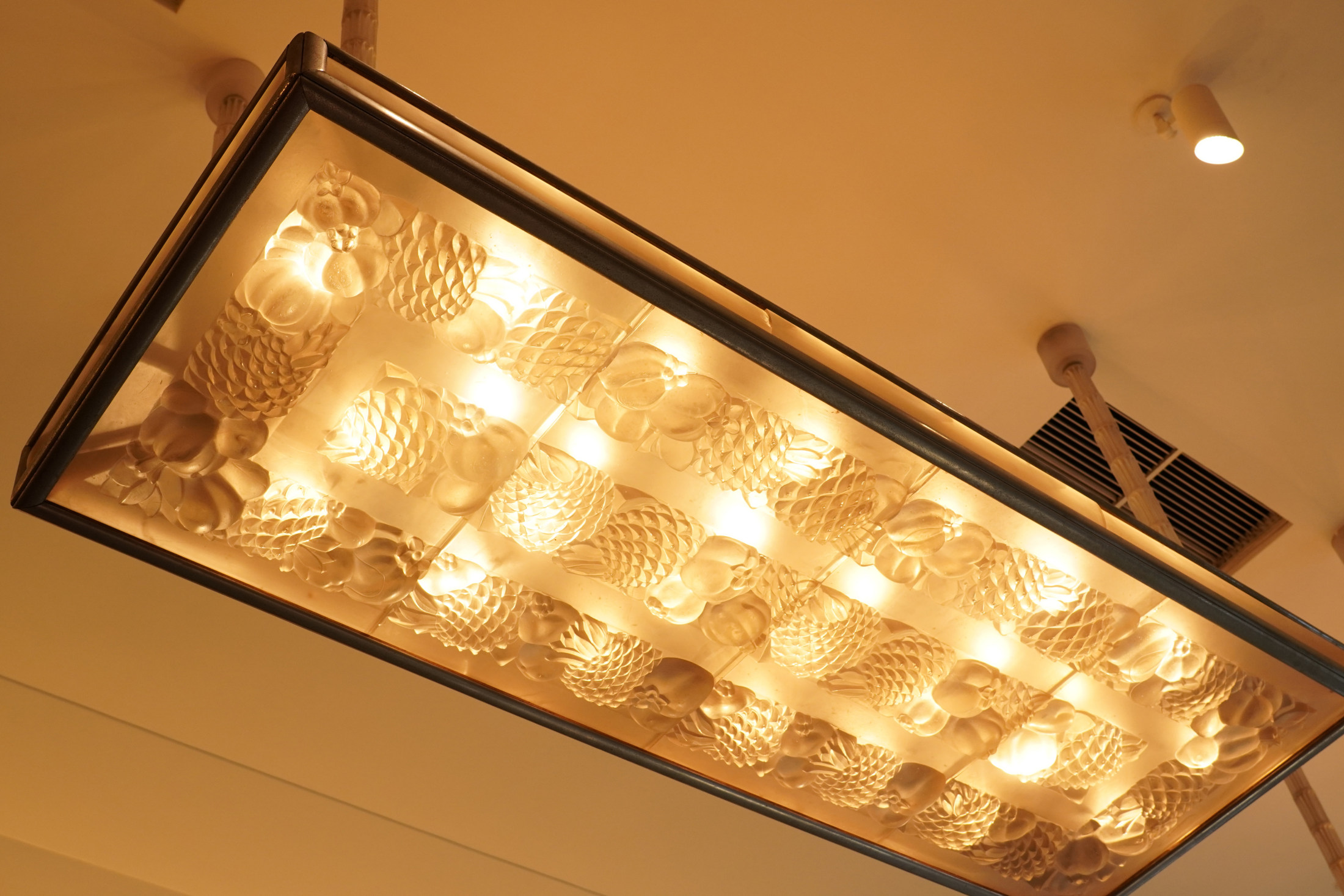
Muta: This fixture has pineapple and pomegranate motifs and was designed specifically for this residence by René Lalique, a glass artist who was all the rage at the time. It’s a rare piece, even though it was mass produced later. The wall paintings that continue from the Small Drawing Room just inside the entrance, to the Anteroom, Salon, and Great Dining Roomwere created by Henri Rapin, the leading Art Deco artist at the time, and depict waterfalls, streams, and other water features in a forest setting. In the Great Dining Room, where we’re standing now, the painting above the fireplace depicts a garden with a red pergola (grape trellis) in the center and a fountain with swans. Additionally, the fireplace cover and radiator covers below the windows have a fish design.
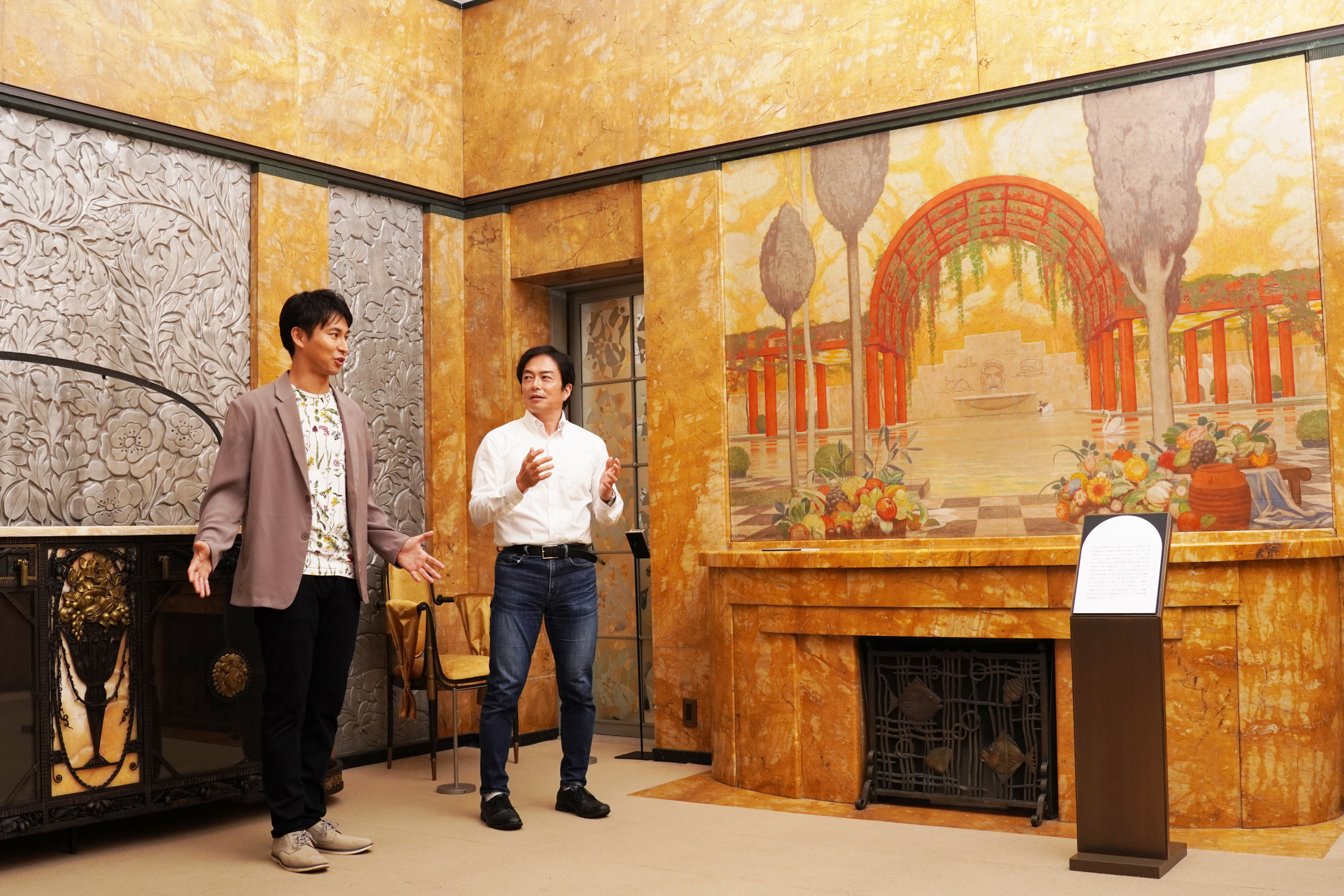
Mikami: It’s like being in a garden while indoors!
Muta: Exactly. Each interior element is a work of art, and there is a sense of overall unity within the space. This room is designed to be functional as a dining hall, while also symbolizing that functionality through the decorations. Normally, to protect the artworks, the museum does not allow outside light in. However, for this exhibition, we left the curtains open so that the garden can also be enjoyed as a work of art.
Mikami: The view from the windows looks just like a painting.
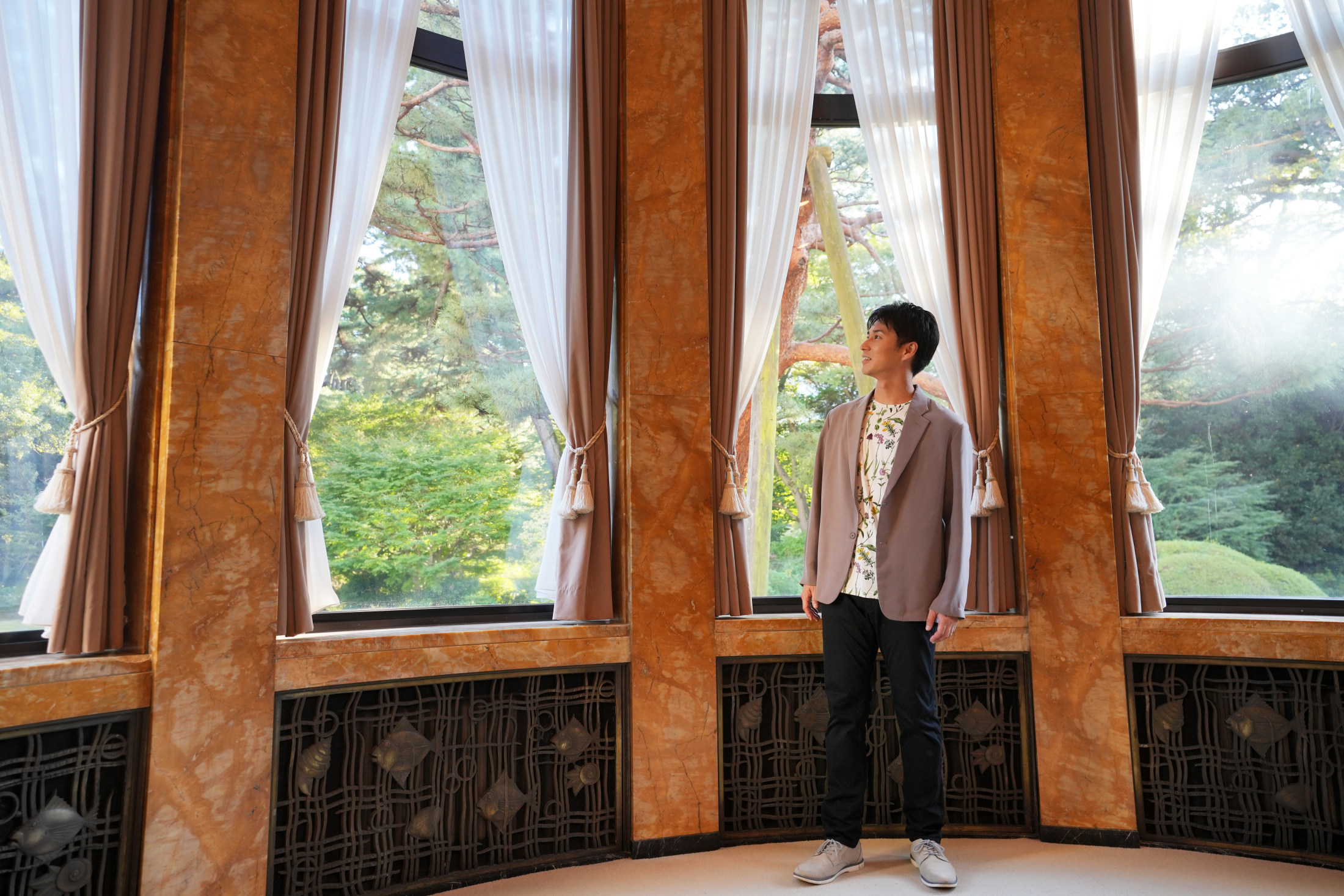
── Finally, the tour reached the Winter Garden on the third floor of the Main Building, which will be specially opened to the public for the duration of The Art Deco Garden exhibition.
Muta: This room is a conservatory for keeping plants in the winter, but it wasn’t used that way during the Prince Asaka Residence era. The checkered marble and German tubular steel furniture are characteristic features of this room, which has been staged to recreate teatime in the residence.
Mikami: It’s nice and warm here with the natural daylight from the glass windows spanning the wall. The layout is unique in that the checkered pattern extends from the floor to the walls, making the room look more spacious than it is.
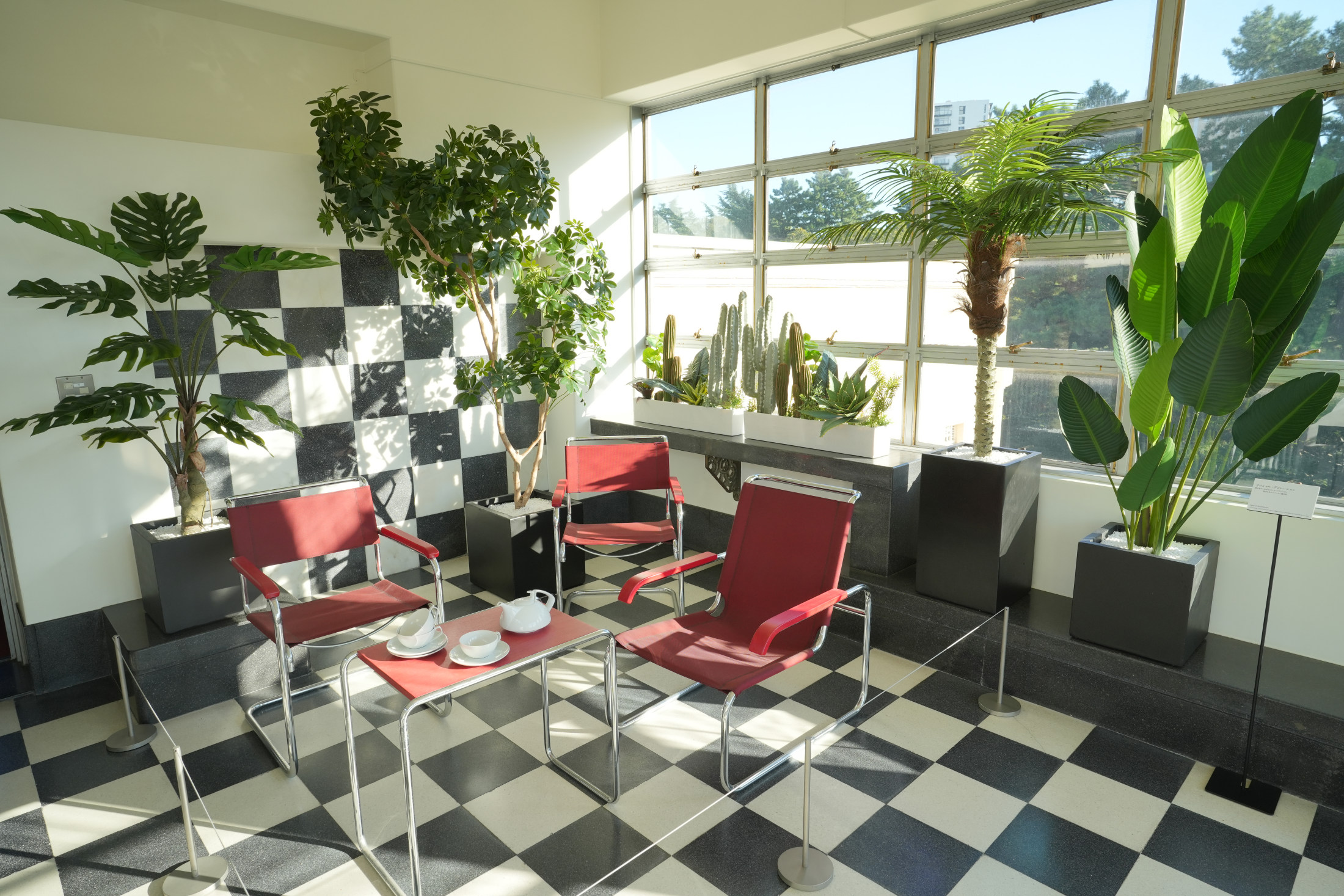
Muta: While the Main Building features famous designers in the Art Deco style, this is a special room that was designed with an emphasis on functionality, as in the Bauhaus school, while being decorative at the same time. It was influenced by the industrialization of society that was happening in Europe and the United States, so we can see combinations of geometric patterns.
Mikami: So that’s where the sense of fusion comes from.
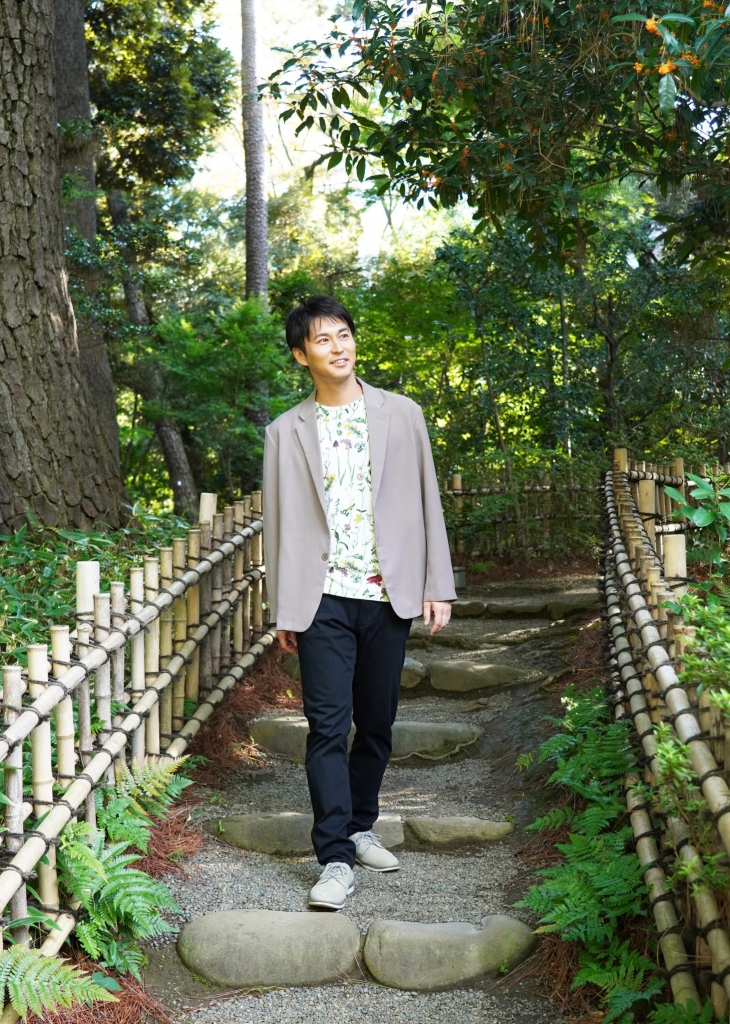
── When asked about his impressions after viewing the gardens and Main Building, Mikami replied, “My perception of the Teien Art Museum changed after I learned about its origins.”
Mikami: The museum has a deep history, and this has been preserved in many ways. Also, the geological features of this area are so good that I wonder if Prince Asaka, who loved to cultivate plants, chose this site specifically for its fertile soil. The artistic sensibility behind this beautiful garden combines the artificial French style and natural English style with Japanese taste, and all of it ties back to the museum. It’s a place in the middle of the city where you can empty your mind and spend time at one with nature.
── Mikami then shared an anecdote about the “power of plants.”
Mikami: A long time ago, my grandfather was raising a Hall crabapple (Malus halliana) tree, and when I was born, he grafted a piece of it onto a tree he planted in my parent’s yard to commemorate my birth. Unfortunately, my grandfather passed away right before I was born, and I never got to meet him. Yet I feel that we are connected through the power of this tree.
── Through plants, we too are able to experience the sentiments of the people who once lived and gathered in the area where the Teien Art Museum stands today. With this in mind, why not spend a relaxing day here with the Garden Map in hand? Be sure to visit for the various events commemorating the museum’s 40th anniversary.
Reporting and text: Yuri Shirasaka
Photography: Katsumi Minamoto
Translation: Jena Hayama


